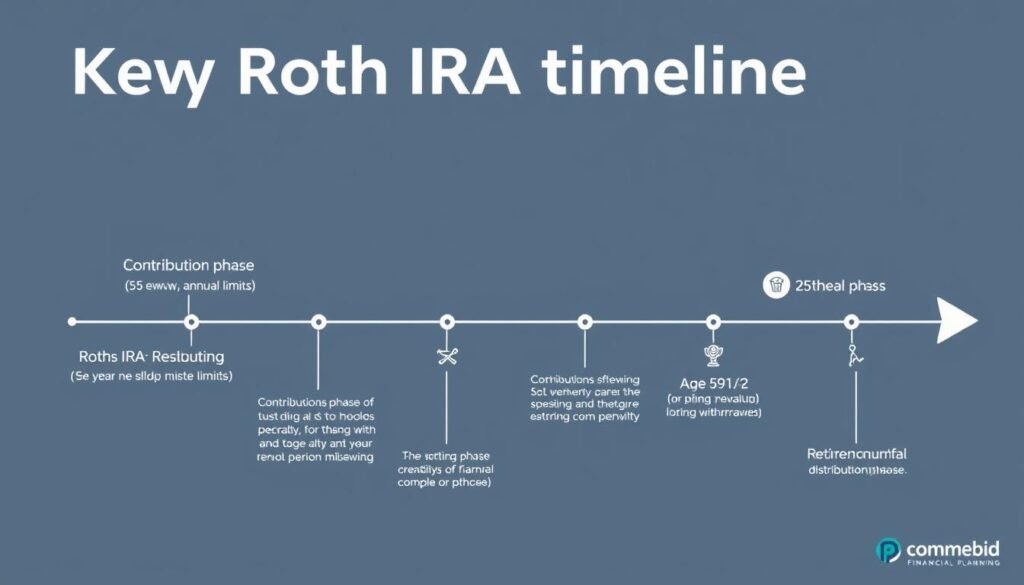Use our Roth IRA Calculator to estimate contributions, growth, and future balance. Plan your retirement and maximize your tax-free savings effectively.
A Roth IRA offers unique tax advantages that can significantly boost your retirement savings. Unlike traditional IRAs, Roth IRAs are funded with after-tax dollars, providing tax-free growth and tax-free withdrawals in retirement. Our Roth IRA calculator helps you estimate how much your retirement savings could grow over time, allowing you to make informed decisions about your financial future.
Roth IRA Calculator
Use this calculator to estimate how much your Roth IRA could be worth at retirement. Enter your information below to get started.

Your Results
| Account Type | Balance at Retirement | Total Contributions | Total Growth | Total Tax Paid |
| Roth IRA | $933,765 | $265,000 | $668,765 | $0 |
| Taxable Account | $663,823 | $265,000 | $531,764 | $132,941 |
Based on the information provided, a Roth IRA could accumulate approximately $269,942 more than a regular taxable account by retirement age. This significant difference demonstrates the powerful tax advantages of a Roth IRA over long-term investing.
Understanding Roth IRAs
A Roth IRA is a special type of Individual Retirement Arrangement that provides tax-free growth and tax-free income in retirement. Established by the Taxpayer Relief Act of 1997 and named after Senator William Roth, this retirement vehicle offers unique advantages compared to traditional retirement accounts.

Key Features of Roth IRAs
Contributions
- Made with after-tax dollars
- Not tax-deductible in the year of contribution
- Can be withdrawn tax-free at any time without penalty
- Subject to annual contribution limits
- Income restrictions apply for eligibility
Distributions
- Tax-free withdrawals in retirement (after age 59½)
- No required minimum distributions (RMDs)
- Earnings can be withdrawn tax-free after account is 5+ years old and you’re 59½+
- Special provisions for first-time home purchases and education expenses
Explore More Retirement Calculators
Planning for retirement requires multiple tools. Check out our other retirement calculators to create a comprehensive strategy.
Roth IRA Contribution Limits
The IRS sets annual limits on how much you can contribute to a Roth IRA. These limits are adjusted periodically for inflation. Additionally, your ability to contribute to a Roth IRA may be reduced or eliminated if your income exceeds certain thresholds.
| Year | Contribution Limit (Under 50) | Contribution Limit (50 or older) |
| 2024 | $7,000 | $8,000 |
| 2025 | $7,000 | $8,000 |
Income Limits for 2025

| Filing Status | Full Contribution | Partial Contribution | No Contribution |
| Single, Head of Household | Less than $150,000 | $150,000 – $164,999 | $165,000 or more |
| Married Filing Jointly | Less than $236,000 | $236,000 – $245,999 | $246,000 or more |
| Married Filing Separately | N/A | Less than $10,000 | $10,000 or more |
If your income exceeds these limits, you may still be able to contribute to a Roth IRA through a “backdoor” conversion strategy. This involves contributing to a Traditional IRA and then converting those funds to a Roth IRA.
How Our Roth IRA Calculator Works
Our Roth IRA calculator uses compound interest formulas to project the growth of your retirement savings. Here’s how the calculations work:

Calculator Inputs Explained
- Starting Balance: The current amount in your Roth IRA.
- Annual Contribution: How much you plan to contribute each year. The calculator assumes contributions are made at the beginning of each year.
- Current Age: Your age today.
- Retirement Age: When you plan to retire. The calculator assumes your last contribution occurs the year before retirement.
- Expected Rate of Return: The annual rate of return you expect from your investments. The default is 6%, which is a conservative estimate for a diversified portfolio over the long term.
- Marginal Tax Rate: Your current tax bracket, used to calculate the tax savings compared to a taxable account.
Calculation Methodology
The calculator uses the following approach:
- Calculates the future value of your starting balance based on the expected rate of return and time until retirement.
- Calculates the future value of each annual contribution, accounting for compound growth until retirement.
- Adds these values to determine your total Roth IRA balance at retirement.
- Compares this to a taxable account where investment returns are taxed annually at your marginal tax rate.
The power of a Roth IRA comes from tax-free growth. While you pay taxes on contributions now, all future growth and qualified withdrawals are completely tax-free.
Roth IRA vs. Traditional IRA: Which Is Better?
Choosing between a Roth IRA and a Traditional IRA depends on your current financial situation and expectations for the future. Here’s a comprehensive comparison to help you decide:

- Tax-free withdrawals in retirement
- No required minimum distributions (RMDs)
- Contributions can be withdrawn anytime without penalties
- Tax-free growth regardless of future tax rates
- Ideal if you expect higher tax rates in retirement
- Better for estate planning (heirs receive tax-free distributions)
Roth IRA Advantages
- Tax deduction for contributions (if eligible)
- Reduces current taxable income
- No income limits for contributions
- Can be better if current tax rate is higher than expected retirement tax rate
- Allows tax-deferred growth until withdrawal
- Easier to convert to Roth later if desired
Traditional IRA Advantages
When to Choose a Roth IRA
A Roth IRA might be the better choice if:
- You expect to be in a higher tax bracket in retirement
- You want flexibility to withdraw contributions without penalties
- You don’t want to worry about required minimum distributions
- You want to leave tax-free money to your heirs
- You’re early in your career with lower current income
Compare More Retirement Options
Not sure which retirement account is right for you? Use our comparison calculators to see which option maximizes your retirement savings.
Effective Roth IRA Strategies
Maximize the benefits of your Roth IRA with these proven strategies:

Backdoor Roth IRA Conversion
If your income exceeds the limits for direct Roth IRA contributions, you can still fund a Roth IRA through a backdoor conversion:
- Contribute to a Traditional IRA (no income limits apply)
- Convert the Traditional IRA to a Roth IRA
- Pay income tax on the converted amount
- Enjoy tax-free growth and withdrawals in retirement
Important: The IRS “pro-rata rule” may affect the tax treatment of backdoor Roth conversions if you have existing pre-tax IRA balances. Consult with a tax professional before implementing this strategy.
Contribution Timing
You can make Roth IRA contributions for a given tax year until the tax filing deadline (typically April 15) of the following year. This gives you flexibility in timing your contributions. Consider these approaches:
- Lump Sum: Contribute the full annual amount early in the year to maximize tax-free growth
- Dollar-Cost Averaging: Make regular monthly contributions to reduce the impact of market volatility
- Last-Minute: Wait until the tax filing deadline to make contributions if you’re uncertain about eligibility
Investment Allocation
Since Roth IRAs offer tax-free growth, consider placing investments with the highest growth potential in your Roth IRA:
- Growth stocks and equity funds with high appreciation potential
- Real estate investment trusts (REITs) that generate significant taxable income
- High-yield bonds or dividend-paying stocks
Frequently Asked Questions
Can I withdraw money from my Roth IRA before retirement?
Yes, you can withdraw your contributions (but not earnings) from a Roth IRA at any time without taxes or penalties. Earnings can be withdrawn tax-free and penalty-free if your account is at least five years old and you’re at least 59½, or if you meet certain exceptions like first-time home purchase (up to ,000) or qualified education expenses.
What happens if I contribute too much to my Roth IRA?
If you contribute more than allowed to your Roth IRA, you’ll face a 6% excess contribution penalty tax each year until you correct the error. You can fix this by withdrawing the excess contribution and any earnings before your tax filing deadline (including extensions), or by applying the excess to a future year’s contribution.
Can I have both a Roth IRA and a 401(k)?
Yes, you can contribute to both a Roth IRA and a 401(k) in the same year. This strategy, known as “tax diversification,” gives you both pre-tax and after-tax retirement savings. However, your ability to contribute to a Roth IRA is still subject to income limits, regardless of your 401(k) participation.
How does a Roth IRA affect my taxes?
Roth IRA contributions are made with after-tax dollars, so they don’t reduce your current taxable income. However, qualified withdrawals in retirement are completely tax-free, including all earnings. Additionally, Roth IRA contributions may qualify you for the Saver’s Tax Credit if your income is below certain thresholds.

Where to Open a Roth IRA
Roth IRA accounts can be opened at various financial institutions. When choosing where to open your account, consider factors like investment options, fees, customer service, and educational resources.
| Institution Type | Advantages | Best For |
| Online Brokerages | Low fees, wide investment selection, robust tools | Self-directed investors comfortable managing their own investments |
| Robo-Advisors | Automated management, low minimums, diversification | Hands-off investors seeking professional management at low cost |
| Traditional Banks | In-person service, account integration, familiarity | Those who prefer face-to-face interactions and consolidated accounts |
| Investment Firms | Full-service options, personalized advice, comprehensive planning | Investors seeking professional guidance and broader financial planning |

Making the Most of Your Roth IRA
A Roth IRA can be a powerful tool in your retirement planning strategy, offering unique tax advantages that can significantly boost your long-term savings. By understanding contribution limits, investment strategies, and withdrawal rules, you can maximize the benefits of this versatile retirement account.
Use our Roth IRA calculator to estimate your potential retirement savings and compare different scenarios. Remember that consistent contributions, even small ones, can grow substantially over time thanks to the power of compound growth and tax-free withdrawals.

Start Planning Your Retirement Today
Use our suite of retirement calculators to create a comprehensive retirement strategy tailored to your financial goals.